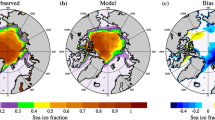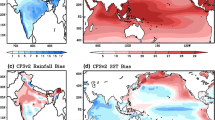Abstract
Indian summer monsoon is a global scale phenomenon controlled by different land, ocean, and atmospheric parameters. Sea surface temperature (SST) and snow are two of the major parameters, which may alter the spatial and temporal patterns of circulation and rainfall during Indian summer monsoon. In the current paper, we study the monsoon variability using long integrations (20 years) of the Indian Institute of Technology Delhi (IITD) Spectral model at T80L18 resolution with observed and climatological SST and snow. Study shows response of IITD GCM in simulating the Indian summer monsoon rainfall and circulation relative to the snow and SST as boundary conditions. The model’s response to SST and snow is examined by conducting four types of experiments by varying observed and climatological values of snow and SST. This paper discusses the seasonal total rainfall for country as a whole and 850 and 200 hPa wind for the period of 20 years starting from 1985 to 2004. The model has been integrated in the ensemble mode with five different initial conditions from the last week of April and first week of May. The model is able to capture the climatological patterns of seasonal total rainfall and averaged wind at lower and upper levels. Observed snow in the presence of climatological SST as a boundary condition shows much impact on rainfall and circulation than observed SST in the presence of climatological snow. Model performance is good in simulating the normal and excess monsoon conditions; it shows poor skill in capturing deficit monsoon years.






Similar content being viewed by others
References
Baede APM, Jarraud M, Cubasch U (1979) Adiabatic formulation and organisation of ECMWF’s spectral model. ECMWF Tech Rep No 7:40
Bamzai AS, Shukla J (1999) Relation between Eurasian snow cover, SD and the Indian summer monsoon: an observational study. J Clim 12:3117–3132
Barnett TP, Dumenil L, Schlese U, Roeckner E, Latif M (1989) Effect of Eurasian snow cover on regional and global limate variations. J Atmos Sci 46(6):661–685
Buizza R (1997) Potential forecast skill of ensemble prediction and spread and skill distributions of the ECMWF ensemble prediction system. Mon Weather Rev 125:99–119
Charney JG, Shukla J (1981) Predictability of monsoons. In: Lighthill SJ, Pearce RP (eds) Monsoon dynamics. Cambridge University Press, pp. 99–109
Chen TC, Yen MC (1994) Interannual variation of the Indian monsoon simulated by the NCAR community climate model: effect of the tropical Pacific SST. J Clim 7:1403–1415
Cohen J (1994) Snow cover and climate. Weather:151–156
Dash SK, Chakrapani B (1989) Simulation of a winter circulation over India using a global spectral model. Earth Planet Sci Proc Indian Acad Sci Sect 98:189–205
Dash SK, Mohandas S (2005) Comparative study of different orographic representations with respect to the Indian summer monsoon simulation. Acta Geophys Pol 53(3):325–340
Dash SK, Singh GP, Vernekar AD, Shekhar MS (2004) A study on the number of snow days over Eurasia, Indian rainfall and seasonal circulations. Meteorog Atmos Phys 86:1–13
Dash SK, Singh GP, Shekhar MS, Vernekar AD (2005) Response of the Indian summer monsoon circulation and rainfall to seasonal snow depth anomaly over Eurasia. Clim Dyn 24:1–10
Dash SK, Partha Sarthi P, Panda SK (2006) A study on the effect of Eurasian snow on the summer monsoon circulation and rainfall using a spectral GCM. Int J Climatol 26:1017–1025
Dickson RR (1984) Eurasian snow cover versus Indian monsoon rainfall - an extension of the Hahn-Shukla results. Ctim Appl Met 23:171–173
Douville H, Royer JF (1996) Sensitivity of the Asian summer monsoon to an anomalous Eurasian snow cover within the metro-France GCM. Clim Dyn 12:449–466
Fennessy MJ et al. (1994) The simulated Indian monsoon: a GCM sensitivity study. J Climatol 7:33–43
Folland CK, Rowell DP (eds) (1995) Workshop on the simulations of the climate of the twentieth century using GISST, Hadley Centre for Climate Prediction and Research. CRTN, Bracknell, p 56
Hahn DG, Shukla J (1976) An apparent relationship between Eurasian snow cover and Indian monsoon rainfall. J Atmos Sci 33:2461–2462
Halder S, Dirmeyer PA (2017) Relation of Eurasian snow cover and Indian summer monsoon rainfall: importance of the delayed hydrological effect. AMS J Clim 30(4):1273–1289
Joseph PV (1981) Ocean atmosphere interaction on a seasonal scale over North Indian Ocean and Indian monsoon rainfall and cyclonic track – a preliminary study. Mausam 32:237–246
Kar SC, Sugi M, Sato N (2001) Interannual variability of the Indiansummer monsoon and internal variability in the JMA globalmodel simulations. J Meteoreol Soc Japan 79:607–623
Keshavamurthy RN (1982) Response of the atmosphere to sea surface temperature anomalies over the equatorial Pacific and the teleconnections of the southern oscillation. J Atmos Sci 39:1241–1259
Kirtman BP, Shukla J (2000) On the influence of the Indian summer Monsoon on ENSO. Q J R Meteor Soc, 126:213–239
Kitoh A (1991) Interannual variations in an atmospheric GCM forced by the 1970-1989 SST. Part I: response of the tropical atmosphere. J Meteorol Soc Japan 69:251–269
Kripalani RH, Kulkarni A (1999) Climatology and variability of historical soviet snow depth data: some new erspectives in snow-Indian monsoon tele-connections. Clim Dyn 15:475–489
Molteni F, Palmer TN (1993) Predictability and finite-time instability of the northern winter circulation. Q J R Meteorol Soc 119:269–298
Mooley DA, Parthasarathy B (1984) Indian summer monsoon rainfall and the east equatorial Pacific Sea surface temperature. Atmosphere-Ocean 22:23–35
Palmer TN, Brankovic C, Viterbo P, Miller MJ (1992) Modeling interannual variations of summer monsoons. J Clim 5:399–417
Panda SK, Dash SK, Bhaskaran B, Pattnayak KC (2016) Investigation of the snow-monsoon relationship in a warming atmosphere using Hadley Center climate model. Glob Planet Chang 147:125–136
Peings Y, Douville H (2009) Influence of the Eurasian snow cover on the Indian summer monsoon variability in observations and CMIP3 simulations. Clim Dyn 34:643–660
Rajeevan M, Pai DS (2006) On El Nino-Indian Monsoon Predictive Relationships. Research Report No: 4/2006, National Climate Centre, India Meteorological Department
Rajeevan M, Bhate J, Kale JD, Lal B (2005) Development of a high resolution daily gridded rainfall data for the Indian region. Met. Monograph Climatology No. 22/2005, National Climate Centre, India Meteorological Department
Saha SK, Halder S, Kumar KK, Goswami BN (2011) Pre-onset land surface processes and ‘internal’ interannual variabilities of the Indian summer monsoon. Clim Dyn 36:2077–2089
Sankar Rao M, Lau MK, Yang S (1996) On the relationship between Eurasian snow cover and the Asian summer monsoon. Int J Climatol 16:605–616
Satyaban BR, Sikka DR, Mohit D, Venkata Ratnam J (2011) Dynamical simulation of Indian summer monsoon circulation, rainfall and its interannual variability using a high resolution atmospheric general circulation model. Int J Climatol 31:1927–1942
Shukla J (1975) Effect of Arabian Sea-surface temperature anomaly on Indian summer monsoon: a numerical experiment with the GFDL model. J Atmos Sci 32:503–511
Shukla J (1981) Dynamical predictability of monthly eans. J Atmos Sci 38:2547–2572
Shukla J, Mintz Y (1982) Influence of land-surface evapotranspiration on the earth’s climate. Science 215:1498–1500
Toth Z, Kalnay E (1997) Ensemble forecasting at NCEP and the breeding method. Mon Weather Rev 127:3297–3318
Turner AG, Slingo JM (2010) Using idealized snow forcing to test teleconnections with the Indian summer monsoon in the Hadley Centre GCM. Clim Dyn. https://doi.org/10.1007/s00382-010-6010805-3
Vernekar AD, Zhou J, Shukla J (1995) The effect of Eurasian snow cover on the Indian monsoon. J Clim 8:248–266
Washington WM, Chervin RM, Rao GV (1977) Effects of a variety of Indian Ocean surface temperature anomaly patterns on the summer monsoon circulation: experiments with the NCAR general circulation model. Pure Appl Geophys 115:1335–1356
Yasunari T, Kitoh A, Tokioka T (1991) Local and remote responses to excessive snow mass over Eurasia appearing in the northern spring and summer c1imate-a study with the MRI GCM. J Meteorol Soc Japan 69:473–487
Zwiers FW (1993) Simulation of the Asian summer monsoon with the CCC GCM-1. J Clim 6:470–486
Acknowledgements
This work was funded by the Department of Science and Technology (DST), Government of India, under the INDO-KOREA Joint Programme of Cooperation in Science and Technology (DST No: INT/Korea/P-06/2011). The authors are thankful to DST for the sponsored project.
Author information
Authors and Affiliations
Corresponding author
Rights and permissions
About this article
Cite this article
Karri, S., Dash, S.K., Panda, S.K. et al. Relative role of sea surface temperature and snow on Indian summer monsoon seasonal simulation using a GCM. Arab J Geosci 11, 210 (2018). https://doi.org/10.1007/s12517-018-3559-6
Received:
Accepted:
Published:
DOI: https://doi.org/10.1007/s12517-018-3559-6




